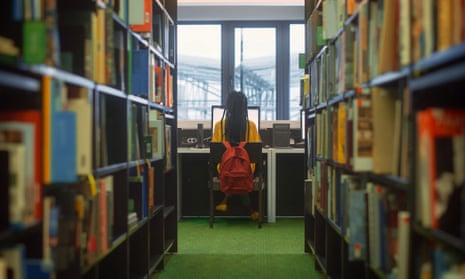Libraries are romantic yet prosaic places. The romance is that of reading, and the wealth of human imagining and learning that is contained in them. Access to the knowledge and literary art (poetry, fiction, drama) in a library is precious, priceless – and particularly valuable to young minds and people of any age with an interest in education. “The library was the place I went to find out what there was to know. It was absolutely essential,” said the novelist Zadie Smith of her own early life.
The prosaic side of libraries is more physical. This is the world of buildings, shelving, books as objects, library cards, fines, computers – and people with bodies that take up space as well as minds that can be opened. It would be hard to find anyone who actively disapproves of libraries, and the principles of self-improvement and pleasure that they stand for. But when it comes to practicalities, Britain’s libraries are on less solid ground. The sector has been cut massively in the past decade, with around 800 libraries across England, Scotland and Wales disappearing.
The first Covid lockdown prompted a new surge of interest in reading, as the idea took hold that people forced to stay at home would spend more time with their noses in books – both finding out more about viral pandemics and escaping from them. But the latest data regarding libraries is sobering reading for anyone who values them as bricks-and-mortar places to go, and as places to sit, use the internet, or seek advice from a librarian – as well as databases. The number of books borrowed in the year ending in March 2021 was 72.9m, down 56% on the previous year. Physical visits also collapsed, from 214.6m to 59.7m, with a glint of silver lining in the fact that website visits grew by 18% to 154.7m.
Of course, this is the behaviour that one would expect during a pandemic. Many libraries were closed during this period, while people were discouraged from unnecessary mixing. Book sales climbed to their highest in a decade in 2021, with fiction especially buoyant, which suggests that some former users of libraries may have bought books instead.
Private libraries at home, whether large collections or single, cluttered bookshelves, appear to be flourishing. But the hope must be that visits and loans at public libraries will soon return to their former level too. Like any other service, libraries need users. And while booksellers might in one sense be regarded as rivals, in fact the vast majority of those involved in the trade, from publishers to poets, are library lovers – as can be seen from the volumes they have inspired, from Susan Orlean’s The Library Book to Matt Haig’s The Midnight Library.
This has something to do with the romantic notion of the reader as explorer, with every book (or at least a good number of them) a door to a new store of feeling or understanding. But it also embodies the recognition that if books are to form part of our mutual life, there must be space in the public realm for them. Books can be treasured possessions, but there is also something special about a copy that arrives in your hands having passed through those of others – and that will go on being passed between strangers who share your curiosity.
